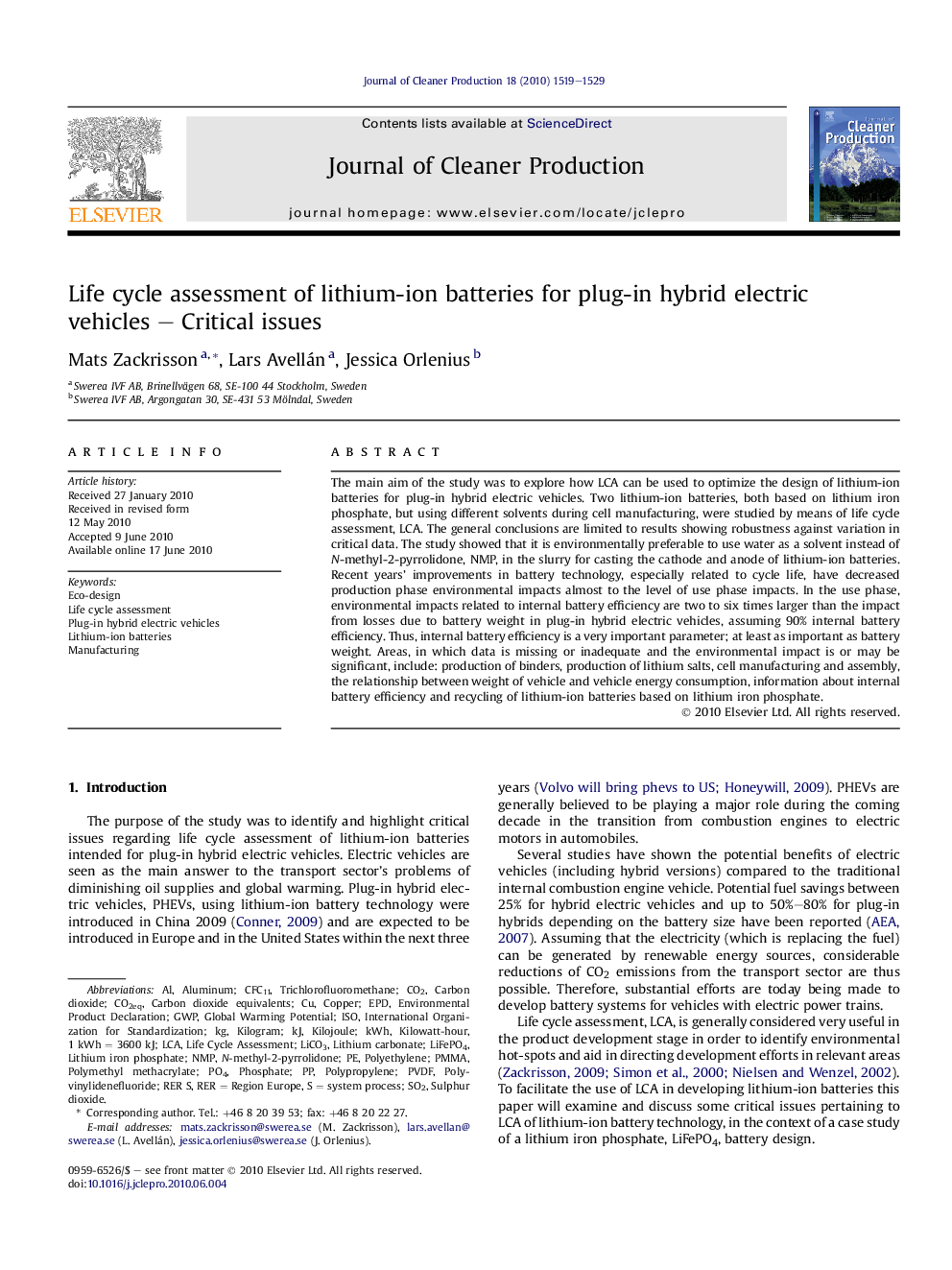| کد مقاله | کد نشریه | سال انتشار | مقاله انگلیسی | نسخه تمام متن |
|---|---|---|---|---|
| 1746378 | 1018093 | 2010 | 11 صفحه PDF | دانلود رایگان |
عنوان انگلیسی مقاله ISI
Life cycle assessment of lithium-ion batteries for plug-in hybrid electric vehicles - Critical issues
دانلود مقاله + سفارش ترجمه
دانلود مقاله ISI انگلیسی
رایگان برای ایرانیان
کلمات کلیدی
EPDCO2eqtrichlorofluoromethaneN-methyl-2-pyrrolidoneGWPNMPLiFePO4PVDFPO4 - PO 4Aluminum - آلومینیوم LCA - ارزیابی چرخه حیاتLife Cycle Assessment - ارزیابی چرخه عمر یا چرخه حیاتenvironmental product declaration - اعلامیه محصول محیط زیستISO - ایزوlithium-ion batteries - باتری های لیتیوم یونSulphur dioxide - دی اکسید گوگردSO2 - دی اکسید گوگردCarbon dioxide - دیاکسید کربنManufacturing - ساختInternational Organization for Standardization - سازمان بین المللی استاندارد سازیEco-design - طراحی محیط زیستPhosphate - فسفاتLithium iron phosphate - فسفات آهن لیتیمCopper - مسCarbon dioxide equivalents - معادل دی اکسید کربنPlug-in hybrid electric vehicles - موتورهای الکتریکی هیبریدی پلاگینglobal warming potential - پتانسیل گرمایش جهانیPMMA - پلی (متیل متاکریلات) Polyethylene - پلی اتیلنpolymethyl methacrylate - پلی متیل متاکریلاتPolyvinylidenefluoride - پلی وینیلیدین فلورایدPolypropylene - پلی پروپیلنCO2 - کربن دیاکسیدLithium carbonate - کربنات لیتیمkWh - کیلووات ساعتKilojoule - کیلوژولkilogram - کیلوگرم
موضوعات مرتبط
مهندسی و علوم پایه
مهندسی انرژی
انرژی های تجدید پذیر، توسعه پایدار و محیط زیست
پیش نمایش صفحه اول مقاله

چکیده انگلیسی
The main aim of the study was to explore how LCA can be used to optimize the design of lithium-ion batteries for plug-in hybrid electric vehicles. Two lithium-ion batteries, both based on lithium iron phosphate, but using different solvents during cell manufacturing, were studied by means of life cycle assessment, LCA. The general conclusions are limited to results showing robustness against variation in critical data. The study showed that it is environmentally preferable to use water as a solvent instead of N-methyl-2-pyrrolidone, NMP, in the slurry for casting the cathode and anode of lithium-ion batteries. Recent years' improvements in battery technology, especially related to cycle life, have decreased production phase environmental impacts almost to the level of use phase impacts. In the use phase, environmental impacts related to internal battery efficiency are two to six times larger than the impact from losses due to battery weight in plug-in hybrid electric vehicles, assuming 90% internal battery efficiency. Thus, internal battery efficiency is a very important parameter; at least as important as battery weight. Areas, in which data is missing or inadequate and the environmental impact is or may be significant, include: production of binders, production of lithium salts, cell manufacturing and assembly, the relationship between weight of vehicle and vehicle energy consumption, information about internal battery efficiency and recycling of lithium-ion batteries based on lithium iron phosphate.
ناشر
Database: Elsevier - ScienceDirect (ساینس دایرکت)
Journal: Journal of Cleaner Production - Volume 18, Issue 15, November 2010, Pages 1519-1529
Journal: Journal of Cleaner Production - Volume 18, Issue 15, November 2010, Pages 1519-1529
نویسندگان
Mats Zackrisson, Lars Avellán, Jessica Orlenius,